-

人教版高中英语必修4A taste of English Humor说课稿3篇
Then I would ask them to think of a funny English or Chinese and tell it to partners. While telling stories, they can use expressions and some acting to help make the story funny. 5 minutes would be given to do this.Those stories they told there will be the material for their writing. Soletting them tell it at first is helpful. And they can make a difference between telling a funny story and writing it down. Generally speaking, it is difficult forstudents to write well because they don’t know what to write and how to write. Asking them to tell their own stories at first can help them come up with what to write.After their telling, I would invite someone to share his/her story with all of us and I would write it down on the blackboard.This example story would be used as a sample to illustrate the format of funny story. Different from a story from teacher or textbook, a story from students can obviously become a interesting material to draw students’ attention.Then I would ask the whole class to put this story into several parts. It might be a little bit difficult for them. So I would ask them to find out whether all the sentences are necessary. After delete some sentences, there are 6 sentences left behind. Then they can easily put them into three parts. After interaction with students, I would teach them the right terms for each part and conclude the format of funny story.This step is the key and difficult point in my lesson. So I mainly usetask-based teaching method in this part and the task for students was divided into several stages. With the separated difficult level, students can find there are usually three parts in writing. They can also learn to write without the unnecessary parts in the process of analyzing. And then I wouldn’t rush to tell them the right terms to them directly. Instead, I would ask them to name them by their own. A confused mind is better for acquiring knowledge.While-writing:Then I would give students 7 minutes to write down this story, without other requirements.With all the preparations in pre-writing, students’ difficulties were cleared. So it would be much easier for them to write down the story within 7 minutes. There are no other requirements because students’ first writing is actually a drafting. It would be revise and edit several times later. Writing, as a skill

人教版高中英语必修3Canada-the true north说课稿4篇
Good afternoon, teachers, It’s my great pleasure to be here sharing my lesson with you.The content of my lesson is Senior English Book 3 Unit 5 Canada —— “The true North”.I’ll be ready to begin this lesson from five parts. Analysis of the teaching material,the teaching methods,the studying methods, the teaching procedure,and Blackboard design.First, let me talk about the teaching material.Part 1 Teaching Material:This unit is about the introduction of Canada. By studying of this unit,we’ll enable the students to learn the geography, population, main cities, and natural beauty, natural resources of Canada. Through the training of the unit, it also requires students to learn some Language skills such as the expressions of position and emotions.So it plays an important part in the English teaching in this book.After studying the teaching material and analyzing the rule of children’s growing of mind,I think the teaching aims are the followings:1.Knowledge objects:(1) make the students learn some new words and phrases(2) make the students understand the content of the lesson.2.Ability objects:(1)To develop the Ss’ abilities of listening, speaking, reading and writing. Especially reading and speaking ability.(2) learn to talk about the characters of Canada in English(3)To train the Ss’ ability of working in pairs.3.Emotion objects:(1)Enable students to understand the characters of Canada..(2)Stimulate Ss to work hard to make China stronger.Part 2 Teaching Methods:I think helping students learn to master new words and phrases and improve the students’ reading and speaking ability is import and the difficult.According to the analysis of the teaching material and the import points and the difficult points,I will use the following teaching methods : question-guiding approach; fast-reading and careful reading; multi-media teaching methods; discussion

人教版高中英语必修4Working The Land说课稿3篇
Knowledge objectives:(1) to make Ss grasp the usage of words, expressions and sentence structures: statistics, struggle, thanks to, rid of, some patterns for persuasion, the “ing” form as subject and object;(2)to use learnt knowledge to persuade sb.Ability objectives:(1) to develop Ss’ reading skills(skimming, scanning, word guessing);(2) to improve Ss’ speaking, communicating and cooperating skills.Emotional objectives:to make Ss know the contribution of Yuan,and learn his spirit and his simple life time.Teaching important and difficult points:(1) some words, expressions and sentence structures mentioned above;(2)the content of the text;(3)training their reading and speaking skills.Teaching methods: CLT, TBLT,QT.Learning strategies: CLS, QLS, TBLS.Teaching procedures:Step 1 lead-in: (1) teacher plays a piece of recent news from CCTV about the harvest of the super hybrid rice, and ask students whether they know Yuan or not, and talk about him and his contribution.(2)Brain storm: let Ss describe Yuan in their minds including his appearance, his living condition and so on.Step 2 fast reading tasks:(1)teacher introduces Yuan and super hybrid rice(2)make Ss read the text as fast as possible with questions. Such as: what’s the general ideaof this passage? What’s Yuan’ dream? (skimming and scanning skill)Step 3 intensive reading tasks(1)let Ss read the text silently, find topic sentence of each paragraph and draw the difficult sentences and the knowledge what they don’t understand.(words guessing)(2)teacher and Ss talk about the important words, expressions and sentences together, and ask Ss to retell the content of the text.(summarizing and paraphrasing)(3)teacher summarize this part.(4) read again following the courseware.

人教版高中英语必修3The million pound bank note说课稿3篇
在接下来的细读环节,我套用了高考对阅读理解的考查方式设置了5个问题,分别为三个推理判断题,一个细节题和一个主旨大意题。学生需要对文章的内容进行分析、归纳、推理、猜测等高级思维活动才能做出正确的回答。【设计意图】这一过程是对学生进行细读的训练,培养学生获取特定信息和挖掘文章深层次信息的能力。第三环节:Intensive-reading (精读) 15′第三个环节精读,既是最重要的环节,也是突破本课重难点的关键。首先,让学生思考剧本中人物看到百万英镑前后的态度发生了怎样的变化。其次,让学生仔细阅读文章,找出可以表现人物态度变化的具体的语言和动作。最后,让学生总结人物的态度发生变化的根本原因是什么,从而引出Money Talks, 供学生思考。【设计意图】通过一系列的活动培养学生学习从人物的语言和动作探究人物的心理,使学生进一步体会戏剧语言的魅力,从而对文章背后所反映的社会问题进行思考,也为下一步的讨论环节做好铺垫。

人教版高中英语必修5Making the news说课稿4篇
今天我们来介绍一下必修五第四单元的授课方式。这个单元的题目是Making the news。应该是学生比较感兴趣的话题,学生往往对新闻工作充满好奇,所以我们可以利用这个机会多设计一些师生互动和学生互动,来激发起学习的积极性,提高学习效率。同时我们可以利用这个单元不仅帮助学生掌握语言知识,培养语言能力,同时让其了解新闻工作的重要性,培养起社会智能感。这个单元分为六个课时,它的教学目标是这样的:语言目标是掌握词汇表中的常用单词和短语,掌握倒装句的一些基本用法。 技能目标是能初步掌握约会的基本句型并在真实的场景下正确运用。新闻报道类文章的写作技能。采访的基本规范和沟通技能。情感目标是对新闻报道的客观性和真实性有更好的理解。对新闻记者的职业有更深入的了解,并能体会其工作的重要性。下面我们来介绍一下第一课时的授课方式,第一课的教学目标是这样的第一课时的教学目标语言目标:单词:Occupation, journalist, editor, photographer, curious, personality, enthusiasm

人教版高中英语必修5The United Kingdom说课稿4篇
Teaching Aims:Knowledge 1. Get the students to learn the useful new words and expressions in this section. Aims:2. Let the students learn about how the UK was formed and the four groups of invaders.1. Develop students’ reading ability and let them learn different Ability reading skills. Aims:2. Enable students to learn to talk about the United Kingdom and the Union Jack Emotional 1. Let students know more about the UK2. Develop students’ sense of cooperative learning Aims:Teaching Important Points:1. Let the students learn about the countries of the United Kingdom and the Union Jack2. Get the students to read the passage and know about how the UK was formed and the four groups of invaders.3. Have the students learn different reading skills.Teaching Difficult Ponts:1. Develop students’ reading ability.2. Enable students to talk about the United Kingdom and the Union Jack.3. Let students learn how the UK was formed geographically and historically.Teaching Methods:Showing pictures, asking, exercising, listening, reading etc.Teaching Aids:A computer,a projector and a blackboard.Teaching Procedures: 1) Show a map of the world, ask students the following questions:Where is the UK?What’s the full name of the UK?2) Ask the students work in pairs to do the quiz on Page 9.Do you want to test how many things you know about the United Kingdom? Let’s have a small test.Using the map on P9, students answer the following questions:?How many countries does the UK consist of? What are they??England is divided into three main areas. Do you know what they are? 1) Scanning (10Minutes )Let the students hold the questions asked in pre-reading and read the passagequickly and then let them do the following exercise.Join lines to the right answer.

部编版语文八年级下册《一滴水经过丽江》说课稿
一、说教材:《一滴水经过丽江》这篇课文是作者应当地政府之约,为中学生写的一篇有关丽江的散文,义务教育教科书八年级下五单元新选的一篇游记散文,这是一篇别具一格游记,与一般游记作品以人的游踪为线索不同,作者化身为一滴水,以水的游踪为线索,展开对古城丽江自然风光,人文风情进行描绘,构思新颖,视觉独特。表现作者对丽江的喜爱和赞美二、教学目标:培养知识和技能:1.学习以物为叙述角度,按地点转换安排结构的写作手法2.体会作者以一滴水的视角去游览丽江的新颖构思。情感、态度与价值观培养热爱祖国风光,热爱祖国灿烂文化,为把祖国建设得更美好而努力学习。重点: 学习以物为叙述角度,按地点转换安排结构的写作手法难点: 会作者化身为一滴水经过丽江,介绍丽江的新颖构思和独特视角把握景物描写的特点
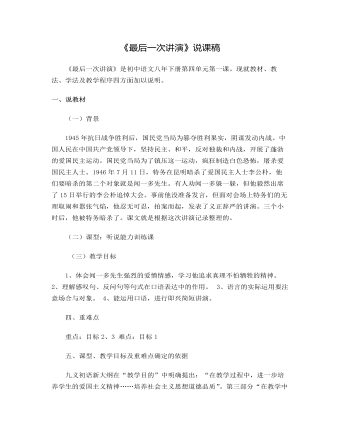
部编版语文八年级下册《最后一次讲演》说课稿
大纲第二条第三款:口语交际要讲究文明和修养,态度自然,尊重对方,注意场合和对象。这是初语教学的重要内容。第三条三款、四款:教学中应注意的问题指出:要重视学生思维能力的发展,教学过程要突出学生的实践活动,提倡灵活多样的教学方式。因此将此文教学定为听说能力训练课。 本文是初语八年级下册第四单元第一课。八年级下册教学重点之一就是“着重培养学生实际运用语言的能力”,因此,本册一至三单元分别安排了语言运用的简明、连贯、得体的训练。本单元的语言实际运用要求得体即说话要注意场合与对象。单元训练目标为演讲与辩论。本文为演讲的范文,学习此文后,要求学生能演讲,会演讲。所以确定了目标2、3、4。

人教版高中语文必修1《小狗包弟》说课稿
探究、讨论、交流:1、包弟讨人喜欢,作者却不得不将它送走,为什么?2、送走包弟后,作者为什么先是感觉轻松,随后觉得沉重?3、“您的小狗怎样?”这句话反复出现,有什么用意?4、“整整十三年零五个月过去了”“整整”一词有什么作用?5、“满园的创伤使我的心仿佛又给放在油锅里熬煎”这句话如何理解?6、“我怀念包弟,我想向它表示歉意。”如何理解?学生各抒己见后教师结合材料发表看法明确总结特别是最后一个问题得出作者这发之心底的语言,不仅仅是歉意,更是发自灵魂深处的忏悔!是对生命的尊重,是一个有良知的作家对反省历史的呼号。第三环节“认识你自己”——忏悔意识与我引导学生正视和反省成长过程中曾犯下过错。并布置课后作业:要求学生课后在本周随笔中谈反省忏悔后的感受。
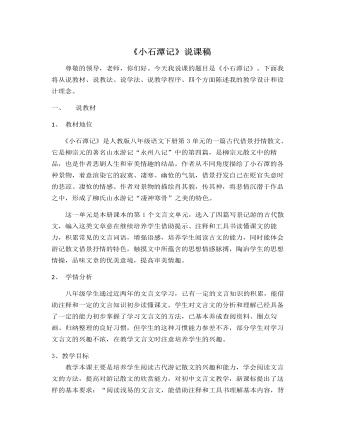
部编版语文八年级下册《小石潭记》说课稿
同学们,今天我们一起来认识一位文化名人。他因长期的贬谪生活,使他的内心十分郁闷,因此,他寄情山水,写下了著名的山水游记《永州八记》。他就是——柳宗元。余秋雨先生曾这样评价柳宗元,他说:“灾难也给了他一份宁静,使他有了足够的时间与自然相晤,与自我对话!”今天,就让我们一同走进柳宗元,走进他的《小石潭记》。(因为这段导语不仅提示了写作背景、文章内容,暗示了作者情感,能为学生学课文作背景、情感铺垫,而且语言很有吸引力,余秋雨的深情评述,易感染学生。导入语亲切,像导游一样引领学生饶有兴趣地进入文本。)(二)朗读、感知、品悟古人云:“三分诗文七分读”。文言文教学应重视积累、感悟和熏陶。要达到这一目的,最有效的手段是诵读。所以这节课我设计了四个朗读环节。(设计意图:在多重对话中理解文本:学生通过四个层次的朗读、品味语言和文本进行对话;通过体味柳宗元情怀与作者进行对话;通过有创见性地探究与生活进行对话;通过合作、交流、分享实现师生、生生之间的对话,在多重对话中达成教学目标。)

人教版高中历史必修2罗斯福新政说课稿2篇
1、教材的地位作用本课是新人教版普通高中历史必修Ⅱ第六单元第18课的内容,阐述罗斯福新政的背景、措施、影响。从单元知识安排看,本课与第17课《空前严重的资本主义世界经济危机》、19课《战后资本主义的新变化》共同诠释第六单元课题——《资本主义世界经济政策的调整》。说明了“资本主义经济理论和政策随着资本主义发展而不断调整的特点”,凸显了“市场调节”和“国家干预”在经济发展中的重要性。从知识体系看,它是学生学习了第一次工业革命后自由资本主义、第二次工业革命后的垄断资本主义等之后出现的,既是对上述知识的巩固与综合运用,又为学生学习必修二的相关内容打下基础,有承上启下的作用。本课三个子目从逻辑上看又是递进关系。第一个子目“临危受命”承上启下,说明了罗斯福上台的历史背景具有临危受命的特点,第二个子目“实施新政”讲述了罗斯福新政的主要内容,第三个子目“摆托危机困境”主要讲述了罗斯福新政的影响。
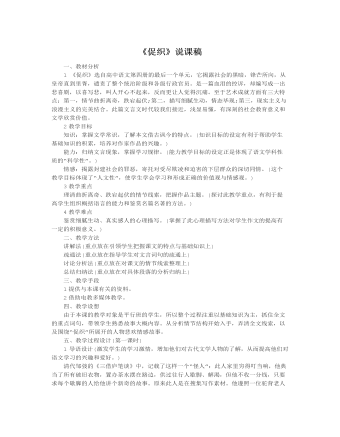
《促织》说课稿2020-2021学年统编版高中语文必修下册
蒲松龄(1640——1715)字留仙,一字剑臣,号柳泉居士。山东淄川(今淄博)人。清代小说家,出身于没落地主家庭。天资聪明,学问深厚,十九岁时连中县、府、道三个第一,但此后屡应省试不第,年七十一,始被补上岁贡生,一生忧郁自伤,穷愁潦倒。从二十岁左右开始写作,历时二十余年,创作了文言短篇小说集《聊斋志异》。另有诗、文集《聊斋诗集》、《聊斋文集》。《聊斋志异》是蒲松龄倾力创作的文言短篇小说集。“聊斋”是作者的书斋名。“志异”就是记述花妖狐鬼及其他一些荒诞不经的奇闻轶事。作者巧妙地通过这些离经虚幻的故事,大胆地揭露社会多方面的黑暗现实,赞美了青年男女敢于冲破封建礼教樊篱的精神,抒发了作者自己满腔的“孤愤”。郭沫若曾题蒲松龄故居联:“写鬼写妖,高人一等;刺贪刺虐,入木三分。”老舍题联:“鬼狐有性格,笑骂成文章。”简明而生动地道出了《聊斋志异》的文学特点。
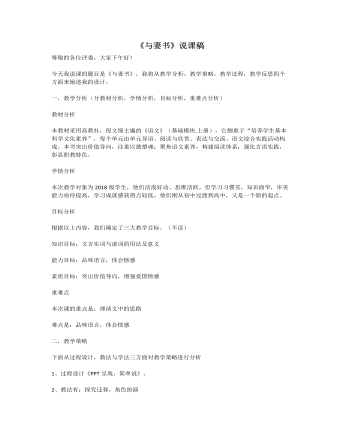
《与妻书》说课稿2020—2021学年统编版高中语文下册
二,教学策略下面从过程设计,教法与学法三方面对教学策略进行分析1、过程设计《PPT呈现,简单说》。2、教法有:探究迁移,角色扮演3、学法有:小组讨论,自主学习,三,教学过程本次课前预习,课中学习,课后练习三个环节。(一)课前准备课前准备环节分前置性学习和课前诊断。前置性学习可通过微课,教材等课程资源,对相关知识进行自学,了解背景,疏通文义,实行小检测。(二)课中学习课中学习环节分自主学习,合作探究,拓展延伸三个步骤。步骤一,自主学习文言实词与虚词的用法及意义,总结规律。步骤二,围绕题目展开,理清文中思路,并品味语言,体悟情感。学生先自由讨论发言,分析品味文中的语言所包含的情感,揣摩人物的心理,说话的语气,然后读出来,大家分享。老师也可以参与,师生共读共赏,最后可以听听名家朗诵音频,进行多向比较鉴赏。

人教版高中历史必修2开辟新航路说课稿3篇
一、说教材《开辟新航路》是高中《历史·必修二》第5课的内容。从三个方面向学生介绍了欧洲人开辟新航路的历史:即新航路开辟的原因和条件、新航路开辟经过以及影响。前4课内容介绍了古代中国经济的基本结构与特点,从第5课开始学习资本主义世界市场的形成和发展。本课内容相当重要,上承古代中国,下启近代世界。新航路的开辟,打破了世界相对隔绝的状态,世界真正开始融合为一个整体。从此,以西欧为中心的世界市场的雏形开始出现。随后的殖民扩张,世界市场拓展;第一次工业革命,世界市场基本形成;第二次工业革命,世界市场发展。二、说目标1、课程标准概述迪亚士、哥伦布开辟新航路的史实,认识地理大发现对世界市场形成的意义。2、三维目标①知识与能力:掌握新航路开辟的原因、经过、影响。②过程与方法:引导学生分析原因及影响,培养学生分析和归纳问题的能力。③情感态度与价值观:A、通过对新航路开辟过程的学习,使学生感受和学习探险家们勇于进取的开拓精神。B、通过学习新航路开辟的影响,使学生认识新航路开辟促进了人类社会的整体发展。
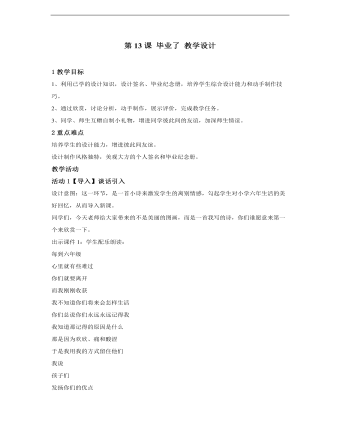
小学美术人教版六年级下册《第13课毕业啦》教学设计说课稿
活动1【导入】谈话引入设计意图:这一环节,是一首小诗来激发学生的离别情感,勾起学生对小学六年生活的美好回忆,从而导入新课。同学们,今天老师给大家带来的不是美丽的图画,而是一首我写的诗,你们谁愿意来第一个来欣赏一下。出示课件1:学生配乐朗读:每到六年级心里就有些难过你们就要离开而我刚刚收获我不知道你们将来会怎样生活你们总说你们永远永远记得我
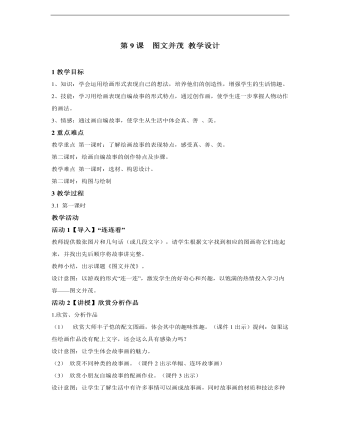
小学美术人教版六年级下册《第9课图文并茂3》教学设计说课稿
2重点难点教学重点第一课时:了解绘画故事的表现特点,感受真、善、美。第二课时:绘画自编故事的创作特点及步骤。教学难点第一课时:选材、构思设计。第二课时:构图与绘制3教学过程3.1 第一课时教学活动活动1【导入】“连连看” 教师提供数张图片和几句话(或几段文字),请学生根据文字找到相应的图画将它们连起来,并找出先后顺序将故事讲完整。教师小结,出示课题《图文并茂》。设计意图:以游戏的形式“连一连”,激发学生的好奇心和兴趣,以饱满的热情投入学习内容——图文并茂。
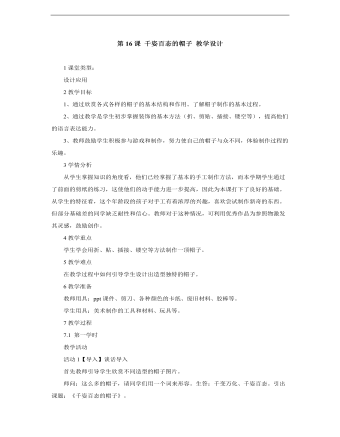
小学美术人教版四年级下册《第16课千姿百态的帽子》教学设计说课稿
1、通过欣赏各式各样的帽子的基本结构和作用。了解帽子制作的基本过程。2、通过教学是学生初步掌握装饰的基本方法(折、剪贴、插接、镂空等),提高他们的语言表达能力。3、教师鼓励学生积极参与游戏和制作,努力使自己的帽子与众不同,体验制作过程的乐趣。3学情分析从学生掌握知识的角度看,他们已经掌握了基本的手工制作方法,而本学期学生通过了前面的剪纸的练习,这使他们的动手能力进一步提高,因此为本课打下了良好的基础。从学生的特征看,这个年龄段的孩子对手工有着浓厚的兴趣,喜欢尝试制作新奇的东西。但部分基础差的同学缺乏耐性和信心。教师对于这种情况,可利用优秀作品为参照物激发其灵感,鼓励创作。
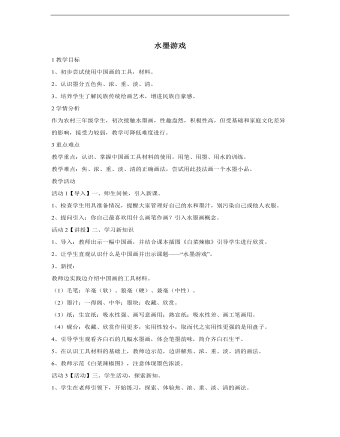
小学美术人教版三年级下册《第1课水墨游戏》教学设计说课稿
3重点难点教学重点:认识、掌握中国画工具材料的使用。用笔、用墨、用水的训练。教学难点:焦、浓、重、淡、清的正确画法,尝试用此技法画一个水墨小品。教学活动活动1【导入】一、师生问候,引入新课。1、检查学生用具准备情况,提醒大家管理好自己的水和墨汁,别污染自己或他人衣服。2、提问引入:你自己最喜欢用什么画笔作画?引入水墨画概念。
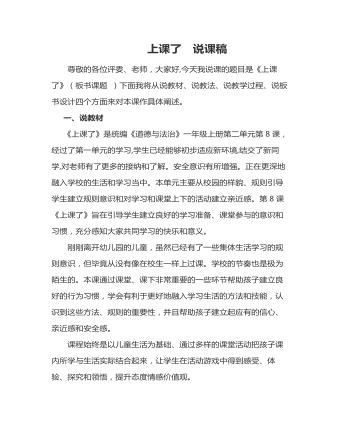
上课了 说课稿
《上课了》是统编《道德与法治》一年级上册第二单元第8课,经过了第一单元的学习,学生已经能够初步适应新环境,结交了新同学,对老师有了更多的接纳和了解。安全意识有所增强。正在更深地融入学校的生活和学习当中。本单元主要从校园的样貌、规则引导学生建立规则意识和对学习和课堂上下的活动建立亲近感。第8课《上课了》旨在引导学生建立良好的学习准备、课堂参与的意识和习惯,充分感知大家共同学习的快乐和意义。刚刚离开幼儿园的儿童,虽然已经有了一些集体生活学习的规则意识,但毕竟从没有像在校生一样上过课。学校的节奏也是极为陌生的。本课通过课堂、课下非常重要的一些环节帮助孩子建立良好的行为习惯,学会有利于更好地融入学习生活的方法和技能,认识到这些方法、规则的重要性,并且帮助孩子建立起应有的信心、亲近感和安全感。课程始终是以儿童生活为基础、通过多样的课堂活动把孩子课内所学与生活实际结合起来,让学生在活动游戏中得到感受、体验、探究和领悟,提升态度情感价值观。
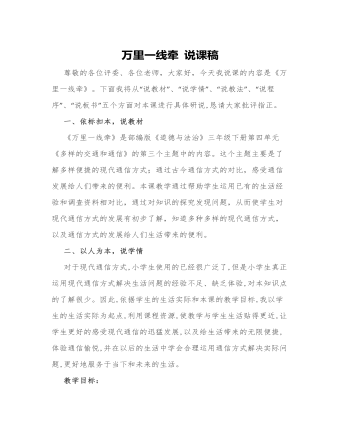
万里一线牵 说课稿
尊敬的各位评委、各位老师,大家好,今天我说课的内容是《万里一线牵》。下面我将从“说教材”、“说学情”、“说教法”、“说程序”、“说板书”五个方面对本课进行具体研说,恳请大家批评指正。一、依标扣本,说教材《万里一线牵》是部编版《道德与法治》三年级下册第四单元《多样的交通和通信》的第三个主题中的内容。这个主题主要是了解多样便捷的现代通信方式;通过古今通信方式的对比,感受通信发展给人们带来的便利。本课教学通过帮助学生运用已有的生活经验和调查资料相对比,通过对知识的探究发现问题,从而使学生对现代通信方式的发展有初步了解,知道多种多样的现代通信方式,以及通信方式的发展给人们生活带来的便利。 二、以人为本,说学情对于现代通信方式,小学生使用的已经很广泛了,但是小学生真正运用现代通信方式解决生活问题的经验不足、缺乏体验,对本知识点的了解很少。因此,依据学生的生活实际和本课的教学目标,我以学生的生活实际为起点,利用课程资源,使教学与学生生活贴得更近,让学生更好的感受现代通信的迅猛发展,以及给生活带来的无限便捷,体验通信愉悦,并在以后的生活中学会合理运用通信方式解决实际问题,更好地服务于当下和未来的生活。

